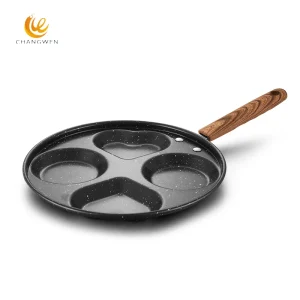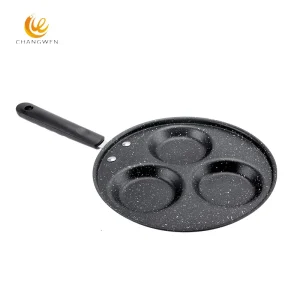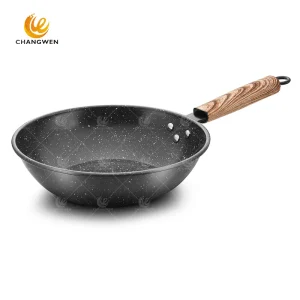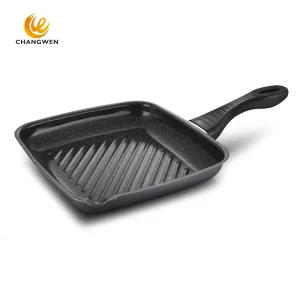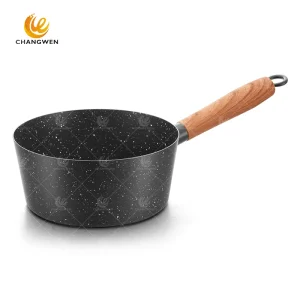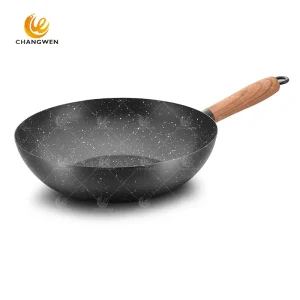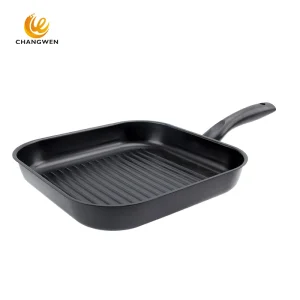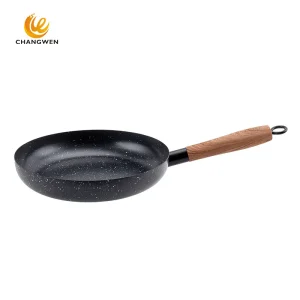Carbon Steel Pan Manufacturer
Carbon steel pan has high heat resistance, excellent thermal conductivity, natural non-stick properties, lightweight and durable, cooking versatility, suitable for all types of stoves including induction, gas and electric.
Home > Carbon Steel Pan
Changwen Carbon Steel Pan
Carbon steel frying pans are also called carbon steel. Compared with cast iron pans, carbon steel frying pans made of this material are relatively lighter and can be thrown.
Carbon steel frying pans can withstand high temperatures like cast iron, store heat, and can perfectly cook steaks. Carbon steel pans are not non-stick pans. Like cast iron pans, they are physically non-stick and have no coating. They require proper maintenance to reduce the risk of sticking to the pan, and the non-stick effect is better than cast iron. However, it is not recommended to cook acidic foods, which will react with food and make the pan flowery.
Suitable for frying, shallow frying, baking, deep frying, and baking. Compatible with gas, induction cookers, electric stoves, ovens, outdoor campfires, etc.
4 Holes egg pan round shape heart shape carbon steel frying pan China factory CW-CS036
Customized 3 holes egg pan carbon steel cookware cooking pan OEM CW-CS035
Factory sale Black wok white dots carbon steel wok with wooden handles China Manufacturer CW-CS021
High Quality carbon steel grill pan kitchen cooking pans China factory OEM CW-CS029
High Quality Saucepan Carbon Steel cookware cooking pots 14/16/18/20cm saucepan China factory CW-CS023
Hot sale Carbon steel cookware single wok whiter dots nonstick wok with wooden handles OEM CW-CS022
New design carbon steel grill pan frying pan cooking pans China manufacturer CW-CS030
New design Easy to hanged Wooden handle carbon steel cookware frypan nonstick frypan China manufacturer CW-CS025
If You Love Cast Iron Pans, You'll Also Love Carbon Steel
Carbon steel and cast iron skillets are both very durable, retain heat extremely well, and are virtually nonstick when properly seasoned. There aren’t many differences between them, but the biggest difference is that cast iron is heavier.
Carbon steel versus cast iron
Carbon steel pans are amazingly versatile and can tackle any job your cast-iron pan can—it even does some things a little better. Here’s a quick rundown of the differences.
Cooking Surface
Carbon Steel: Offers a smoother, less porous surface than cast iron. This quality contributes to more uniform heat distribution and a better sear on proteins. It builds up a non-stick seasoning over time, which is excellent for cooking delicate foods but may be vulnerable to acidic ingredients until well-seasoned.
Cast Iron: Typically has a rougher surface which can affect how food interacts with the pan initially. However, like carbon steel, it improves with seasoning over time. Cast iron’s porous nature means it can hold seasoning well but might require more maintenance to keep its non-stick quality.
Shape
Carbon Steel: Tends to have sloped sides, making it more suitable for tasks like sautéing or acting as a lighter substitute for a wok. This design facilitates easier tossing and stirring.
Cast Iron: Generally features straighter sides, aiding in shallow frying or cooking with more liquid without spillage. The design can retain more heat for a longer duration, suitable for deep-frying or baking.
Heat Conduction
Carbon Steel: As a thinner material, it heats up and cools down more quickly than cast iron. This responsiveness is excellent for recipes requiring precise temperature control, though it may be more prone to warping if mistreated.
Cast Iron: Has excellent heat retention, making it ideal for slow cooking and recipes that benefit from steady, even heat. Its thicker design means it takes longer to warm up and cool down.
Weight
Carbon Steel: Lighter than cast iron, making it easier to handle, especially when flipping or moving food around. The lower weight reduces strain during cooking, particularly beneficial for those with physical limitations.
Cast Iron: Heavier, providing stability but making it more challenging to maneuver, especially larger or full pans. The weight contributes to its heat retention properties and durability.
Maintenance and Durability
Both: Require seasoning to maintain a non-stick surface and prevent rust. With appropriate care, both materials are virtually indestructible. However, carbon steel’s thinner design may require more attention to prevent warping under extreme temperatures.
Versatility
Both: Offer wide-ranging versatility, suitable for various cooking surfaces, including gas, induction, and grill. Each can handle high temperatures and move seamlessly from stovetop to oven.
Conclusion
Choosing between carbon steel and cast iron depends on your specific cooking needs and preferences. Carbon steel offers quick responsiveness and a lighter weight, ideal for high-heat searing, and delicate tasks requiring precise temperature control. Cast iron, renowned for its heat retention and durability, is suited for slow-cooking, baking, and frying.
Why Choose Changwen Carbon Steel Pan?
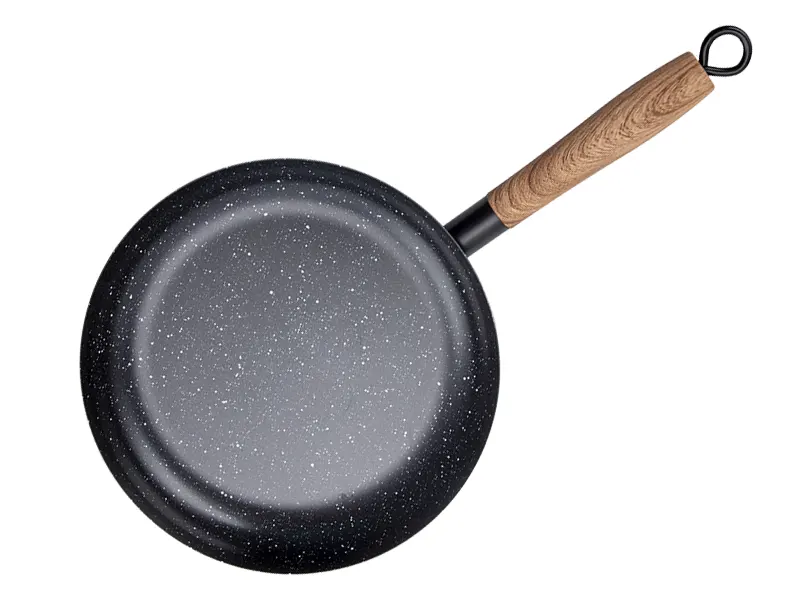
Made of high-quality raw iron ore, refined and purified at 1600°C, no chemical coating is added, second-hand iron recycling is rejected, the material is healthy and the family is at ease.
High-temperature nitriding adds a tight anti-rust protective barrier to the pot body to increase wear resistance and corrosion resistance, and it is rust-free and non-stick.
Lightweight design, the weight is lower than that of traditional cast iron pots. Girls can also operate it with one hand and flip the pot easily.
Using the spinning process, the bottom is thick and the wall is thin, the heat conduction is fast and the heating is uniform, bringing a more enjoyable stir-frying experience.
After the carbon steel pot is properly seasoned, the fine micropores on the surface of the pot wall will absorb excess grease to naturally form an anti-stick oil film, effectively preventing food from sticking to the pot, and achieving a non-stick effect without coating.
Meet Changwen Cast Iron Frying Pan
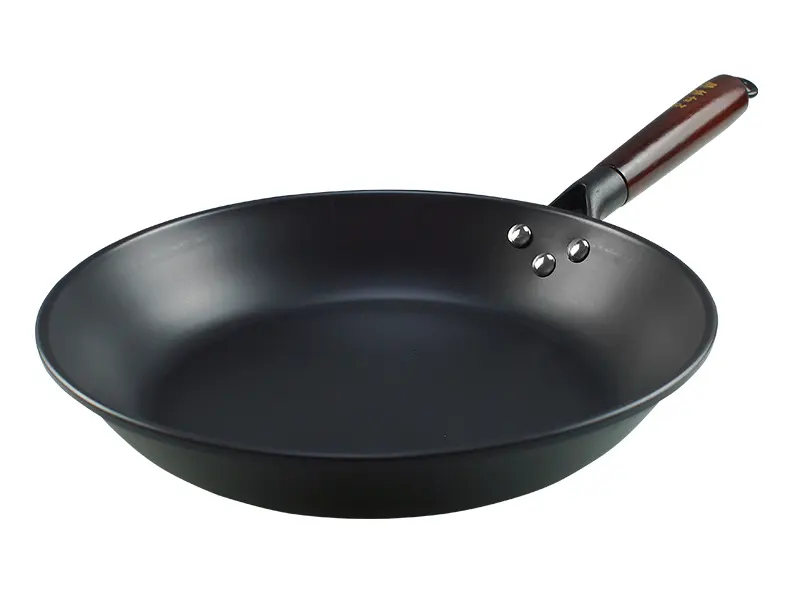
Nitriding Carbon Steel Pan
The original iron ore is smelted at 1550 degrees and purified multiple times, with a fast heating speed and uniform heat conduction.
Nitriding iron nitriding technology, the whole pot is nitrided, not easy to rust, wear-resistant, and the smooth inner wall is easy to clean.
The wall of the chambered iron pot is full of fine bumps and pores. Food grease gradually penetrates during cooking and turns into a natural anti-stick oil film for long-term maintenance, forming a non-stick pot.
Natural beech handle, solid wood material is tough and durable, and feels comfortable to hold.
Reinforced rivet connection, accessories are made of metal, and rivet reinforcement is more stable.
The pot body is formed by one-piece spinning, with the characteristics of thick bottom and thin wall, uniform heat transfer and less oil smoke; the spinning process greatly reduces the weight of the pot body, making it lighter to use.
The weight is lower than that of traditional cast iron pots, which is convenient for ladies to cook delicious food.
Non-stick Carbon Steel Steak Frying Pan
The non-stick carbon steel steak frying pan makes a ceremonial striped steak. The thickened bottom has good heat conduction and heat storage performance, conducts heat evenly and heats quickly, saving energy. The special concave and convex bottom retains 50% of oxygen, drains away excess water and grease, forms striped grill marks, is crispy on the outside and tender on the inside, and locks in the original flavor.
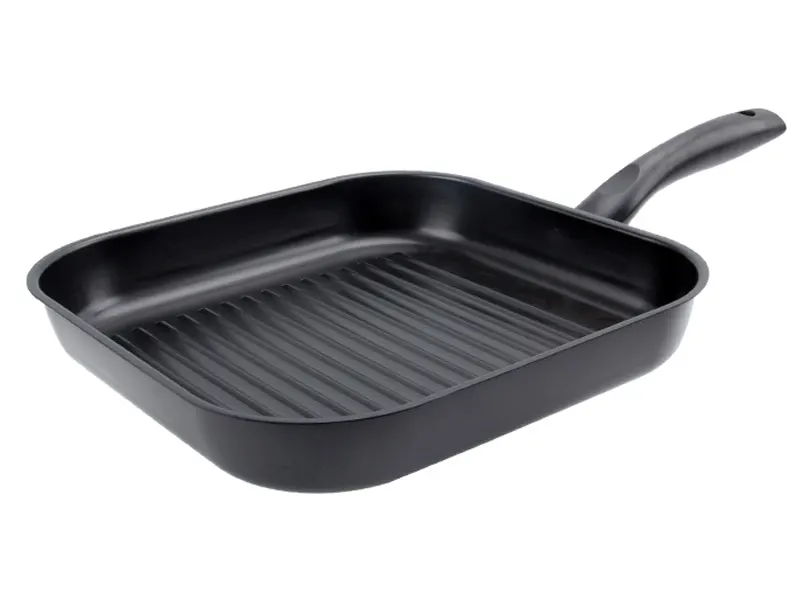
Carbon Steel Pan FAQ
Carbon steel is extremely safe, and it is a great way to cook plenty of dishes. They can achieve non-stick tendencies with regular use, have the ability to handle high heat, and can be easily maneuvered on the stove. Carbon steel is quickly becoming one of the most trusted pieces of cookware in all types of kitchens.
Avoid cooking acidic foods like tomatoes, vinegar-based sauces, and wine in carbon steel pans as they can damage the pan’s seasoning.
Skillets made from carbon steel are lighter than those made from cast iron but still sear beautifully. Carbon steel contains slightly less carbon than cast iron, which makes it less brittle; as a result, it can be made relatively thin and lightweight but still be plenty durable.
While cast iron is slow to heat up, carbon steel pans reach the ideal cooking temperature quickly. The slight bow in the carbon steel cookware allows the pan to cool down quickly. This feature is desirable when cooking delicate foods such as flash frying, sautéing, etc. Cast iron pans have better heat retention.
carbon steel pans
Chefs use carbon steel pans because they can brown and sear food quicker than other utensils. They’re also extremely cost-friendly, sturdy, and durable.
Get a cookware catalog?
WE’RE HERE TO HELP. 24 HOURS A DAY, 7 DAYS A WEEK.


